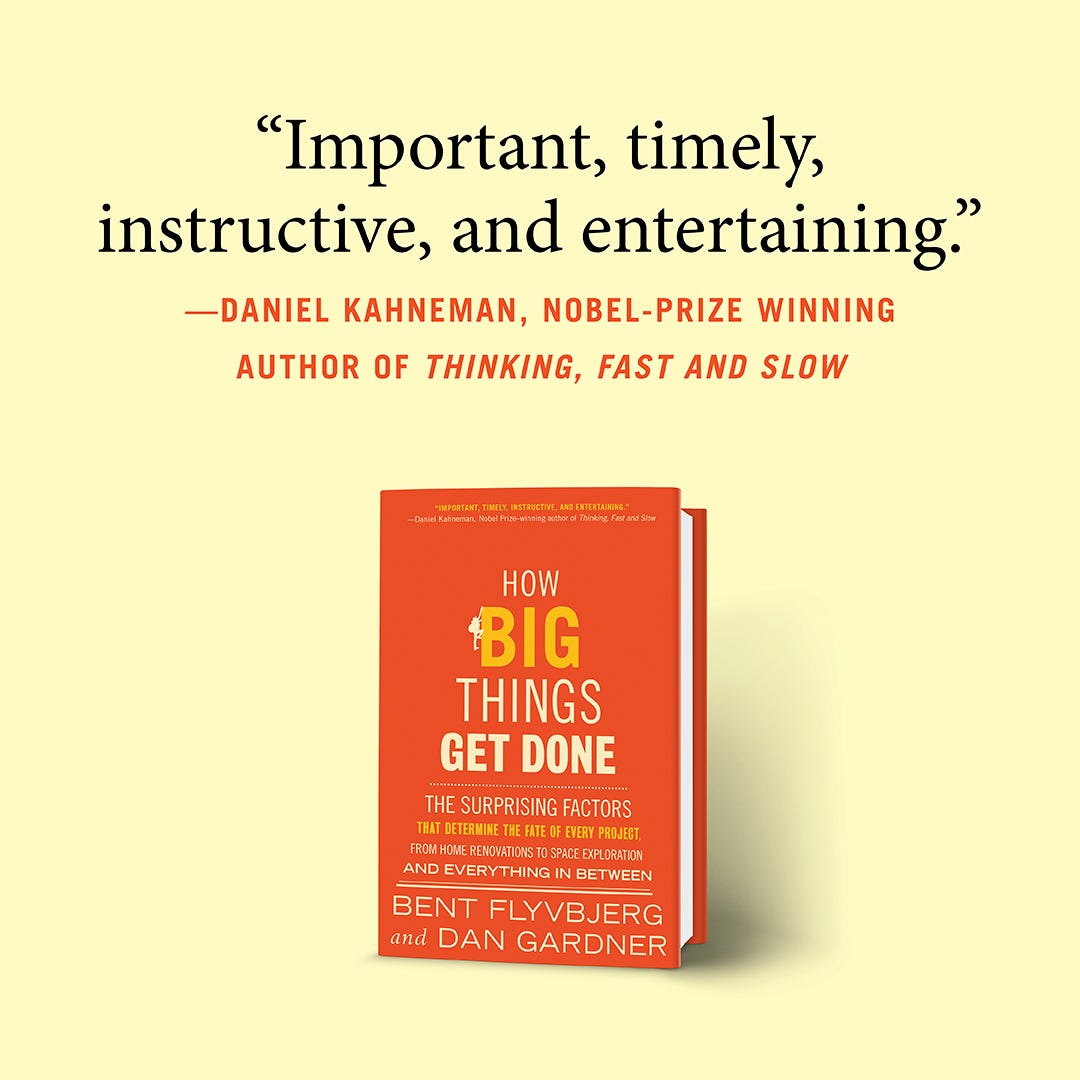Hello, everyone. Apologies for the rare mid-week post. But today is a rare day.
How Big Things Get Done — my fourth book — has been released in the United States and Canada.
So what’s the book about? My co-author, Professor Bent Flyvbjerg of the University of Oxford and the IT University of Copenhagen, is the world’s leading expert on megaprojects, and much of the early press has focused, understandably, on the delivery of giant infrastructure projects and the like. (For example, this review in today’s Wall Street Journal.)
As important as that is — we could literally change the world if we got better at delivering those sorts of projects — the book is much broader than that. Because “big” is relative.
For a small business, getting a modest building designed may be a complex, ambitious project. For a major corporation, an equivalent project may be a skyscraper. For a city, it may be developing an industrial park. For a nation, it may a high-speed rail line or a network of satellites.
But for a homeowner, a renovation may qualify. In fact, the third chapter features the story of the owners of a Brooklyn townhouse who set out to the renovate their kitchen but went about it the wrong way. As a result, they quite unintentionally turned a $170,000 project into a $1,000,000 monstrosity they never would have approved at the outset.
And I can tell you from long personal experience that writing a non-fiction book — turning a vague idea into a proposal, a publishing contract, a draft, and finally publication — can definitely qualify as a “big project.” In How Big Things Get Done, we look at how Robert Caro, arguably the greatest living American biographer, writes his enormously complex books. A sample:
“What is this book about?,” he asks himself. “What is its point?” He forces himself to “boil the book down to three paragraphs, or two, or one.” These paragraphs express the narrative theme with perfect simplicity.
But don’t mistake simple for easy. Caro writes a draft and throws it out. Then another. And another, in seemingly endless iterations. This can go on for weeks as he compares his summary with his voluminous research. “The whole time, I’m saying to myself, ‘no, that’s not exactly what you’re trying to do in this book.’ ” He gets into foul moods. “I come home and [my wife] doesn’t even want to see me for the first several hours.” But the struggle is worth it. When he finally has his precious paragraphs, he pins them to the wall behind his desk, where it is literally impossible for him to lose sight of his goal.
In the long years ahead, as he writes his book, pushing ever deeper into the jungle of his research, in growing danger of getting lost in its complexity, Caro constantly looks at his summary and compares it with what he is currently writing. “Is this fitting in with those three paragraphs?,” he asks himself. “How is it fitting in? What you wrote is good, but it’s not fitting in. So you have to throw it away or find a way to make it fit in.”
With the goal always in view, there is no getting lost. That’s thinking from right to left.
When I shared that story with my editor, she sighed. I’m sure any book editor would, because authors routinely fail to do what Caro does. And they pay the price. She once had an author — years into the writing of a book and six months away from deadline — say to her in conversation, “but….what’s this book really about?” For a project that was supposed to be nearing completion, those are words that freeze the blood.
Understandably, you may think there’s little or nothing that connects the writing of a book to a home renovation to skyscrapers and satellites. In fact, there is. It is people.
People have dreams. These become concepts. Concepts become plans. Plans become work. Work builds a new reality.
At every stage, no matter how much advanced technology is involved, people are the common factor. This is why the reasons for project failure in IT, for example, are often similar or identical to the reasons for project failure in other categories that seemingly have nothing in common — the construction of a skyscraper, the development and launch of a new product, a home renovation, the publication of a new book.
It’s also why the fundamentals of project success transcend category: What Robert Caro does at the start of writing his books is remarkably similar to what Frank Gehry does in the creation of a new building and what Amazon does in the development of a new, consumer-focused project.
This is a book about how people can turn hazy daydreams into concrete reality.
If this is of interest to you, and you think you may buy the book some day, may I ask a wee favour?
Please buy it now.
Book sales are a neat illustration of chaos theory because they are highly sensitive to changes in initial conditions: A small boost early on can compound and multiply in strange and unpredictable ways to produce a dramatically different situation six months or a year ahead.
Or to put that another way: One book sold at the outset is worth far more to the authors than one book sold a year from now.
That’s why I would ask you — if you think you may buy this book sometime — to buy it now.
You can find all the details about where to buy the book right here.
My dependents thank you. Especially my dog, Thor.






Congrats on the new book. I was trudging to work in the Ottawa snow when I remembered today was the day this book came out. I bought it immediately on the kindle.
I am reading this with some trepidation; given I’m in the final stages of a large project at work.
Just finished. What a wonderful book. Great points well made. Is this a good place to discuss the details with others or is there a better one?